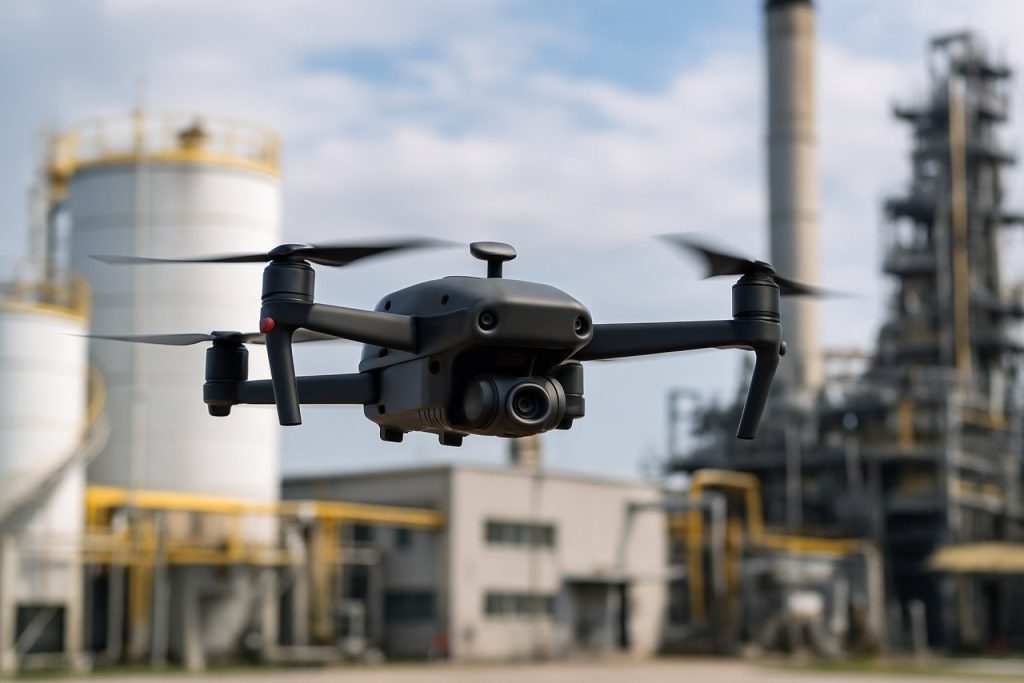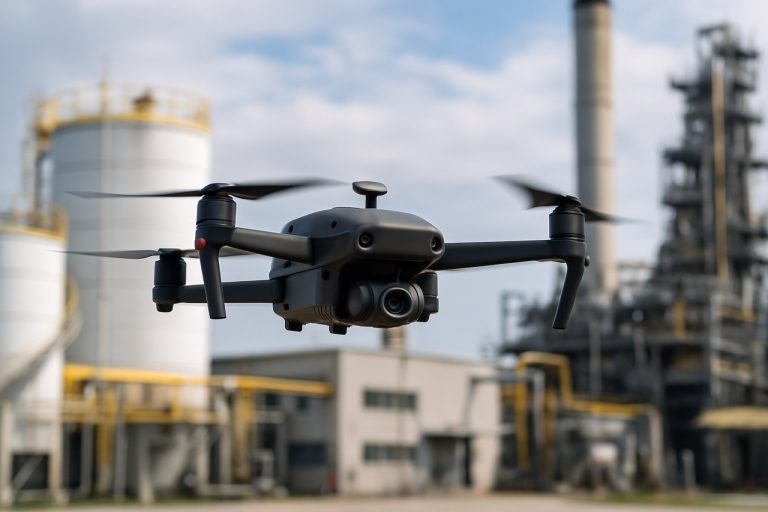
Autonomous Drone Navigation Systems Market Report 2025: In-Depth Analysis of AI Integration, Market Dynamics, and Global Growth Prospects. Explore Key Trends, Forecasts, and Strategic Opportunities Shaping the Industry.
- Executive Summary & Market Overview
- Key Technology Trends in Autonomous Drone Navigation
- Competitive Landscape and Leading Players
- Market Growth Forecasts (2025–2030): CAGR, Revenue, and Volume Analysis
- Regional Market Analysis: North America, Europe, Asia-Pacific, and Rest of World
- Future Outlook: Innovations and Emerging Applications
- Challenges, Risks, and Strategic Opportunities
- Sources & References
Executive Summary & Market Overview
Autonomous drone navigation systems represent a rapidly advancing segment within the broader unmanned aerial vehicle (UAV) market, leveraging artificial intelligence, computer vision, and sensor fusion to enable drones to operate with minimal or no human intervention. As of 2025, the global market for autonomous drone navigation systems is experiencing robust growth, driven by expanding applications across commercial, industrial, defense, and consumer sectors. These systems are critical for enabling drones to perform complex tasks such as obstacle avoidance, real-time mapping, precision delivery, and autonomous surveillance.
According to recent market analyses, the global autonomous drone navigation systems market is projected to reach a valuation exceeding USD 4.5 billion by 2025, with a compound annual growth rate (CAGR) of over 18% from 2022 to 2025. This growth is fueled by increasing investments in drone technology, regulatory advancements supporting beyond visual line of sight (BVLOS) operations, and the integration of advanced navigation technologies such as LiDAR, GNSS, and machine learning algorithms MarketsandMarkets.
Key industry players—including DJI, Parrot, and Lockheed Martin—are investing heavily in R&D to enhance the reliability, safety, and autonomy of their navigation systems. These advancements are enabling new use cases in sectors such as agriculture (precision crop monitoring), logistics (autonomous last-mile delivery), infrastructure inspection, and emergency response. For instance, the adoption of AI-powered navigation is significantly reducing operational costs and improving mission efficiency for enterprises and government agencies alike Grand View Research.
Regionally, North America and Europe are leading the adoption of autonomous drone navigation systems, supported by favorable regulatory frameworks and a strong presence of technology innovators. However, Asia-Pacific is emerging as a high-growth market, propelled by rapid urbanization, smart city initiatives, and increasing demand for automated aerial solutions Fortune Business Insights.
In summary, the autonomous drone navigation systems market in 2025 is characterized by technological innovation, expanding commercial applications, and a dynamic regulatory landscape. The sector is poised for continued expansion as advancements in AI, sensor technology, and connectivity further unlock the potential of fully autonomous UAV operations.
Key Technology Trends in Autonomous Drone Navigation
Autonomous drone navigation systems are at the forefront of innovation in the unmanned aerial vehicle (UAV) sector, enabling drones to operate with minimal or no human intervention. By 2025, these systems are characterized by the integration of advanced sensors, artificial intelligence (AI), and real-time data processing, which collectively enhance the safety, efficiency, and scalability of drone operations across industries.
One of the most significant trends is the adoption of AI-powered perception and decision-making algorithms. These algorithms leverage deep learning and computer vision to interpret complex environments, allowing drones to detect and avoid obstacles, recognize objects, and adapt to dynamic conditions. Companies such as NVIDIA are providing edge computing platforms that enable real-time processing of sensor data onboard the drone, reducing latency and dependence on remote servers.
Simultaneous Localization and Mapping (SLAM) technology is another key advancement. SLAM enables drones to build and update maps of unknown environments while tracking their own location within those maps. This is particularly crucial for indoor navigation and GPS-denied environments, where traditional satellite-based navigation is unreliable. Firms like Intel are developing SLAM-based solutions that combine visual, LiDAR, and inertial sensors for robust navigation capabilities.
Integration with 5G networks is also transforming autonomous navigation. The ultra-low latency and high bandwidth of 5G allow drones to communicate with cloud-based AI models and other drones in real time, facilitating coordinated fleet operations and beyond-visual-line-of-sight (BVLOS) missions. According to Ericsson, 5G connectivity is expected to be a catalyst for large-scale deployment of autonomous drone fleets in logistics, inspection, and emergency response by 2025.
Finally, regulatory compliance and airspace integration are being addressed through the development of Unmanned Traffic Management (UTM) systems. These systems, championed by organizations like the Federal Aviation Administration (FAA), provide real-time tracking, geofencing, and automated flight authorization, ensuring safe coexistence of autonomous drones with manned aircraft.
Collectively, these technology trends are shaping a new era for autonomous drone navigation systems, driving their adoption in commercial, industrial, and public sector applications worldwide.
Competitive Landscape and Leading Players
The competitive landscape for autonomous drone navigation systems in 2025 is characterized by rapid technological advancements, strategic partnerships, and a growing number of both established aerospace companies and innovative startups. The market is driven by increasing demand for drones in commercial, defense, and industrial applications, with navigation systems being a critical differentiator in terms of safety, efficiency, and regulatory compliance.
Leading players in this sector include DJI, which continues to dominate the commercial drone market with its proprietary vision-based navigation technologies and robust R&D investments. Parrot has also strengthened its position by integrating advanced AI-powered navigation features into its ANAFI series, targeting both enterprise and government clients. In the United States, Lockheed Martin and Northrop Grumman are at the forefront of military-grade autonomous navigation, leveraging sensor fusion, machine learning, and secure communication protocols to enhance mission autonomy and resilience.
Startups and specialized technology firms are playing a pivotal role in shaping the competitive dynamics. Skydio has emerged as a leader in fully autonomous navigation, utilizing advanced computer vision and deep learning to enable obstacle avoidance and real-time path planning, which has attracted significant contracts from both commercial and government sectors. senseFly, a subsidiary of AgEagle Aerial Systems, is recognized for its fixed-wing drones equipped with sophisticated GNSS and RTK navigation modules, catering to precision agriculture and surveying markets.
Strategic collaborations are increasingly common, with companies like Intel partnering with drone manufacturers to integrate RealSense technology for enhanced situational awareness. Meanwhile, Qualcomm is advancing the market through its Snapdragon Flight platform, enabling high-performance, low-power navigation solutions for a range of drone types.
- DJI: Market leader in commercial drone navigation systems
- Skydio: Pioneer in AI-driven autonomous navigation
- Lockheed Martin & Northrop Grumman: Defense sector innovators
- Parrot & senseFly: Strong presence in enterprise and industrial applications
- Intel & Qualcomm: Key technology enablers through hardware and software platforms
As regulatory frameworks evolve and end-user requirements become more complex, the competitive landscape is expected to intensify, with innovation in autonomous navigation systems remaining a primary focus for differentiation and market leadership.
Market Growth Forecasts (2025–2030): CAGR, Revenue, and Volume Analysis
The market for autonomous drone navigation systems is poised for robust growth between 2025 and 2030, driven by advancements in artificial intelligence, sensor fusion, and regulatory support for commercial drone operations. According to projections by MarketsandMarkets, the global autonomous drone market—which includes navigation systems as a core component—is expected to register a compound annual growth rate (CAGR) of approximately 20% during this period. This surge is attributed to increasing adoption across sectors such as logistics, agriculture, infrastructure inspection, and defense.
Revenue generated by autonomous drone navigation systems is forecasted to reach $4.2 billion by 2030, up from an estimated $1.7 billion in 2025. This growth is underpinned by the integration of advanced navigation technologies, including real-time kinematic (RTK) positioning, simultaneous localization and mapping (SLAM), and AI-powered obstacle avoidance. The commercial sector is anticipated to account for the largest share of this revenue, as enterprises invest in autonomous solutions to enhance operational efficiency and reduce labor costs.
In terms of volume, the number of autonomous navigation system units shipped is projected to increase from approximately 120,000 units in 2025 to over 400,000 units by 2030, as reported by International Data Corporation (IDC). This rapid expansion is fueled by the proliferation of drone-as-a-service (DaaS) models and the growing need for scalable, reliable navigation in complex environments.
- Regional Growth: North America and Europe are expected to lead in adoption, supported by favorable regulatory frameworks and significant investments in smart infrastructure. Asia-Pacific, particularly China and Japan, will experience accelerated growth due to expanding industrial applications and government initiatives.
- Key Drivers: The primary drivers include advancements in machine learning algorithms, miniaturization of sensors, and the increasing demand for autonomous operations in hazardous or hard-to-reach areas.
- Challenges: Despite strong growth prospects, challenges such as cybersecurity risks, airspace integration, and high initial costs may temper the pace of adoption in certain regions.
Overall, the 2025–2030 period is set to witness significant expansion in both revenue and unit shipments for autonomous drone navigation systems, establishing the technology as a cornerstone of next-generation unmanned aerial operations.
Regional Market Analysis: North America, Europe, Asia-Pacific, and Rest of World
The global market for autonomous drone navigation systems is experiencing robust growth, with regional dynamics shaped by regulatory environments, technological advancements, and sector-specific demand. In 2025, North America, Europe, Asia-Pacific, and the Rest of World (RoW) regions each present distinct opportunities and challenges for market participants.
- North America: North America remains a leader in the adoption and development of autonomous drone navigation systems, driven by strong investments in defense, logistics, and agriculture. The United States, in particular, benefits from supportive regulatory frameworks and significant R&D funding. The Federal Aviation Administration (FAA) continues to expand waivers for beyond-visual-line-of-sight (BVLOS) operations, accelerating commercial deployments. Major players such as Lockheed Martin and Northrop Grumman are advancing AI-powered navigation, while startups focus on urban air mobility and last-mile delivery solutions. According to Grand View Research, North America accounted for over 35% of the global market share in 2024, a trend expected to continue in 2025.
- Europe: Europe’s market is shaped by stringent privacy and safety regulations, but harmonization efforts by the European Union Aviation Safety Agency (EASA) are fostering cross-border drone operations. Countries like Germany, France, and the UK are investing in smart city infrastructure and precision agriculture, driving demand for advanced navigation systems. The European Commission’s Digital Europe Programme is funding AI and sensor integration projects, while companies such as Airbus and Thales Group are leading in autonomous navigation R&D. MarketsandMarkets projects a CAGR of over 18% for the European segment through 2025.
- Asia-Pacific: The Asia-Pacific region is the fastest-growing market, propelled by rapid urbanization, government initiatives, and a burgeoning e-commerce sector. China, Japan, and South Korea are at the forefront, with companies like DJI dominating commercial and consumer drone markets. Government-backed smart agriculture and disaster management programs are boosting adoption. According to Fortune Business Insights, Asia-Pacific is expected to achieve the highest CAGR globally, surpassing 20% in 2025.
- Rest of World (RoW): In regions such as Latin America, the Middle East, and Africa, adoption is slower but rising, particularly in mining, oil & gas, and infrastructure monitoring. Regulatory uncertainty and limited investment remain challenges, but pilot projects and international partnerships are increasing. IDTechEx notes that RoW markets are likely to see double-digit growth as technology costs decrease and regulatory clarity improves.
Future Outlook: Innovations and Emerging Applications
The future outlook for autonomous drone navigation systems in 2025 is marked by rapid innovation and the emergence of new applications across multiple industries. As artificial intelligence (AI), machine learning, and sensor fusion technologies mature, drones are expected to achieve higher levels of autonomy, reliability, and operational safety. This evolution is driven by the need for drones to operate in complex, dynamic environments with minimal human intervention.
One of the most significant innovations anticipated is the integration of advanced AI-powered perception systems. These systems enable drones to interpret and respond to real-time environmental data, facilitating obstacle avoidance, dynamic path planning, and adaptive mission execution. Companies such as NVIDIA are developing edge AI platforms that allow drones to process visual and sensor data onboard, reducing latency and enhancing decision-making capabilities.
Another emerging trend is the adoption of collaborative navigation, where multiple drones communicate and coordinate their movements to accomplish complex tasks. This is particularly relevant for applications in logistics, agriculture, and infrastructure inspection, where swarms of drones can cover large areas efficiently. Research initiatives led by organizations like DARPA are pushing the boundaries of swarm intelligence and cooperative autonomy.
Urban air mobility (UAM) is poised to become a major application area, with autonomous navigation systems enabling safe and efficient drone operations in densely populated environments. Regulatory bodies such as the Federal Aviation Administration (FAA) are working on frameworks to support beyond-visual-line-of-sight (BVLOS) operations, which will unlock new commercial opportunities in package delivery, emergency response, and aerial surveying.
In addition, the integration of 5G connectivity and cloud-based navigation services is expected to enhance real-time data sharing and remote control capabilities. Companies like Ericsson are collaborating with drone manufacturers to leverage ultra-low-latency networks for mission-critical applications.
Looking ahead to 2025, the convergence of AI, edge computing, swarm intelligence, and regulatory advancements will drive the proliferation of autonomous drone navigation systems. These innovations will not only expand the scope of drone applications but also set new standards for safety, efficiency, and scalability in the unmanned aerial vehicle (UAV) market.
Challenges, Risks, and Strategic Opportunities
Autonomous drone navigation systems are at the forefront of transforming industries such as logistics, agriculture, surveillance, and infrastructure inspection. However, as these systems become more sophisticated and widespread in 2025, they face a complex landscape of challenges and risks, alongside significant strategic opportunities for innovation and market growth.
One of the primary challenges is ensuring reliable and safe navigation in dynamic and unpredictable environments. Autonomous drones must process vast amounts of sensor data in real time to avoid obstacles, adapt to changing weather conditions, and comply with evolving airspace regulations. The risk of system failures, GPS spoofing, or cyberattacks remains a critical concern, as highlighted by recent research from the National Institute of Standards and Technology (NIST), which underscores the need for robust cybersecurity frameworks and resilient navigation algorithms.
Regulatory uncertainty is another significant hurdle. While agencies like the Federal Aviation Administration (FAA) and the European Union Aviation Safety Agency (EASA) are developing frameworks for beyond-visual-line-of-sight (BVLOS) operations, the pace of regulatory adaptation often lags behind technological advancements. This creates operational risks for companies seeking to deploy autonomous drones at scale, particularly in urban or densely populated areas.
From a technical perspective, the integration of artificial intelligence (AI) and machine learning (ML) into navigation systems presents both opportunities and risks. While AI-driven perception and decision-making can enhance autonomy and efficiency, they also introduce new vulnerabilities, such as algorithmic bias or susceptibility to adversarial attacks. According to a 2024 report by Gartner, the need for explainable and transparent AI in autonomous systems is becoming increasingly critical for regulatory approval and public trust.
Despite these challenges, strategic opportunities abound. The global market for autonomous drone navigation is projected to grow rapidly, driven by demand for contactless delivery, precision agriculture, and smart city applications. Companies investing in advanced sensor fusion, edge computing, and secure communication protocols are well-positioned to capture market share. Partnerships between technology providers, regulatory bodies, and end-users are also emerging as a key strategy to accelerate safe deployment and foster innovation, as seen in recent collaborations highlighted by International Data Corporation (IDC).
Sources & References
- MarketsandMarkets
- Parrot
- Lockheed Martin
- Grand View Research
- Fortune Business Insights
- NVIDIA
- Northrop Grumman
- senseFly
- Qualcomm
- International Data Corporation (IDC)
- Airbus
- Thales Group
- IDTechEx
- DARPA
- National Institute of Standards and Technology (NIST)
- European Union Aviation Safety Agency (EASA)



